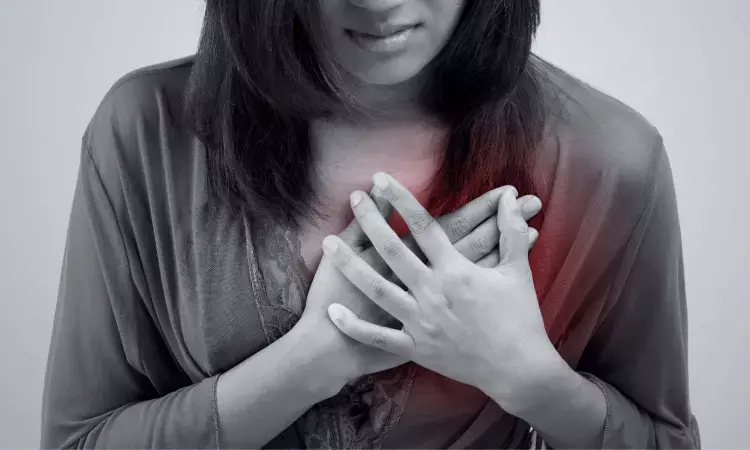- Home
- Medical news & Guidelines
- Anesthesiology
- Cardiology and CTVS
- Critical Care
- Dentistry
- Dermatology
- Diabetes and Endocrinology
- ENT
- Gastroenterology
- Medicine
- Nephrology
- Neurology
- Obstretics-Gynaecology
- Oncology
- Ophthalmology
- Orthopaedics
- Pediatrics-Neonatology
- Psychiatry
- Pulmonology
- Radiology
- Surgery
- Urology
- Laboratory Medicine
- Diet
- Nursing
- Paramedical
- Physiotherapy
- Health news
- Fact Check
- Bone Health Fact Check
- Brain Health Fact Check
- Cancer Related Fact Check
- Child Care Fact Check
- Dental and oral health fact check
- Diabetes and metabolic health fact check
- Diet and Nutrition Fact Check
- Eye and ENT Care Fact Check
- Fitness fact check
- Gut health fact check
- Heart health fact check
- Kidney health fact check
- Medical education fact check
- Men's health fact check
- Respiratory fact check
- Skin and hair care fact check
- Vaccine and Immunization fact check
- Women's health fact check
- AYUSH
- State News
- Andaman and Nicobar Islands
- Andhra Pradesh
- Arunachal Pradesh
- Assam
- Bihar
- Chandigarh
- Chattisgarh
- Dadra and Nagar Haveli
- Daman and Diu
- Delhi
- Goa
- Gujarat
- Haryana
- Himachal Pradesh
- Jammu & Kashmir
- Jharkhand
- Karnataka
- Kerala
- Ladakh
- Lakshadweep
- Madhya Pradesh
- Maharashtra
- Manipur
- Meghalaya
- Mizoram
- Nagaland
- Odisha
- Puducherry
- Punjab
- Rajasthan
- Sikkim
- Tamil Nadu
- Telangana
- Tripura
- Uttar Pradesh
- Uttrakhand
- West Bengal
- Medical Education
- Industry
Assisted reproductive technologies not associated with higher risk of CVD

A new study by Maria Magnus and team showed that women who gave birth after assisted reproductive technologies (ART) had no elevated risk of cardiovascular disease (CVD) after a median follow-up of 11 years when compared to those who conceived without ART. The findings of this study were published in the Journal of American Medical Association.
Globally, the usage of assisted reproductive technologies is rapidly expanding. Because of the small number of studies and their short follow-up period, the results linked with therapy for an individual's long-term health, including risk of cardiovascular disease, remain mostly unclear. So, this study was carried out to determine if the risk of CVD is higher in those who have given birth after ART than those who have delivered without ART.
Using countrywide data from Denmark (1994-2014), Norway (1984-2015), Finland (1990-2014), and Sweden (1985-2015), a registry-based cohort analysis was done. From January through August 2022, data was analyzed. During the research period, a total of 2496441 persons with a registered delivery in national birth registries were included, and 97474 (4%) of these gave birth following ART. ART quality registries and/or medical birth registries provided data on ART conception. Patient and cause of death registries provided CVD information. The risk of CVD was assessed using Cox proportional hazards regression, which adjusted for age, calendar year of start of follow-up, parity, polycystic ovarian syndrome diagnosis, chronic hypertension, diabetes, and country.
The key findings of this study were:
The median period of follow-up was 11 (IQR, 5-18) years.
The mean (SD) age of women who did not use ART was 29.1 (4.9) years, whereas those who did used ART were 33.8 (4.7) years.
The overall CVD rate was 153 per 100 000 person-years. Individuals who had children after taking ART showed no increased risk of CVD, with indications of country heterogeneity.
With the use of ART, there were no significant changes in the risk of ischemic heart disease, stroke, cerebrovascular disease, cardiomyopathy, pulmonary embolism, heart failure, or deep vein thrombosis.
However, there was a trend towards a slight decrease in the likelihood of myocardial infarction, with no significant differences between nations.
Reference:
Magnus, M. C., Fraser, A., Håberg, S. E., Rönö, K., Romundstad, L. B., Bergh, C., Spangmose, A. L., Pinborg, A., Åsvold, B. O., Lawlor, D. A., & Opdahl, S. (2023). Maternal Risk of Cardiovascular Disease After Use of Assisted Reproductive Technologies. In JAMA Cardiology. American Medical Association (AMA). https://doi.org/10.1001/jamacardio.2023.2324
Neuroscience Masters graduate
Jacinthlyn Sylvia, a Neuroscience Master's graduate from Chennai has worked extensively in deciphering the neurobiology of cognition and motor control in aging. She also has spread-out exposure to Neurosurgery from her Bachelor’s. She is currently involved in active Neuro-Oncology research. She is an upcoming neuroscientist with a fiery passion for writing. Her news cover at Medical Dialogues feature recent discoveries and updates from the healthcare and biomedical research fields. She can be reached at editorial@medicaldialogues.in
Dr Kamal Kant Kohli-MBBS, DTCD- a chest specialist with more than 30 years of practice and a flair for writing clinical articles, Dr Kamal Kant Kohli joined Medical Dialogues as a Chief Editor of Medical News. Besides writing articles, as an editor, he proofreads and verifies all the medical content published on Medical Dialogues including those coming from journals, studies,medical conferences,guidelines etc. Email: drkohli@medicaldialogues.in. Contact no. 011-43720751


